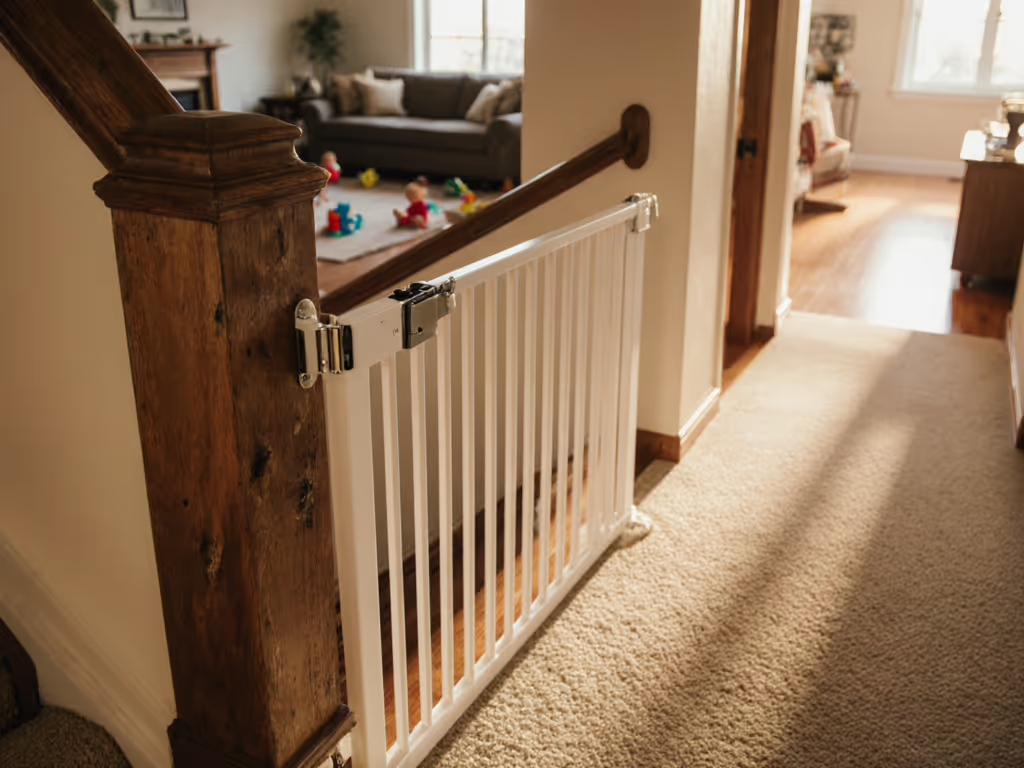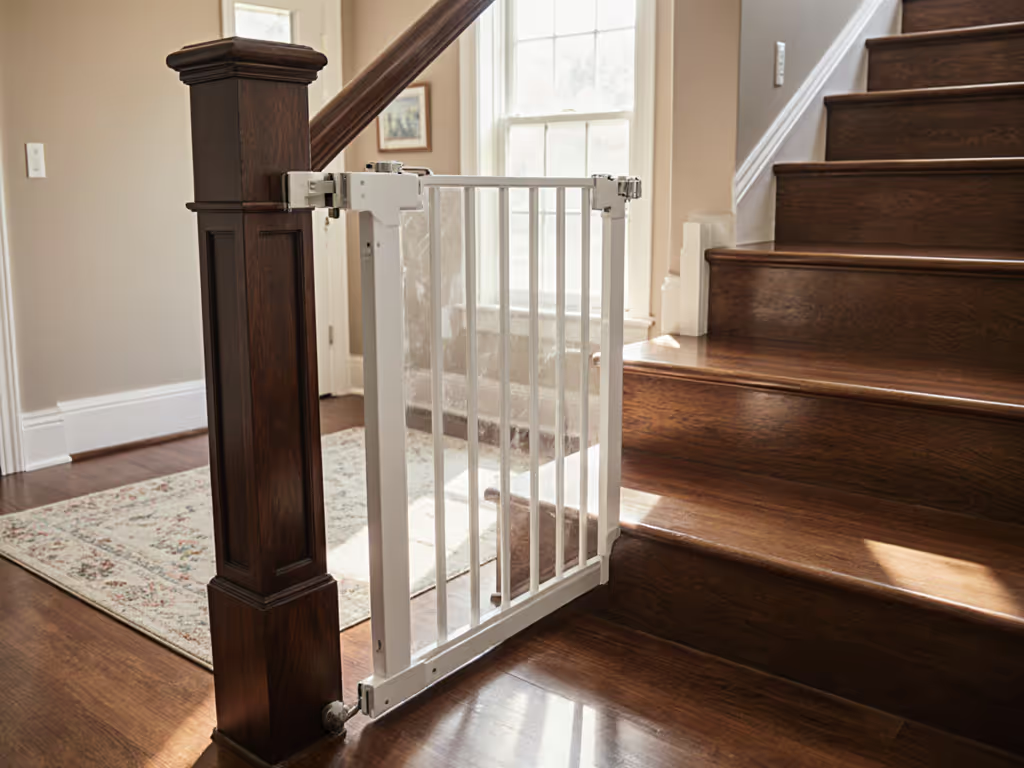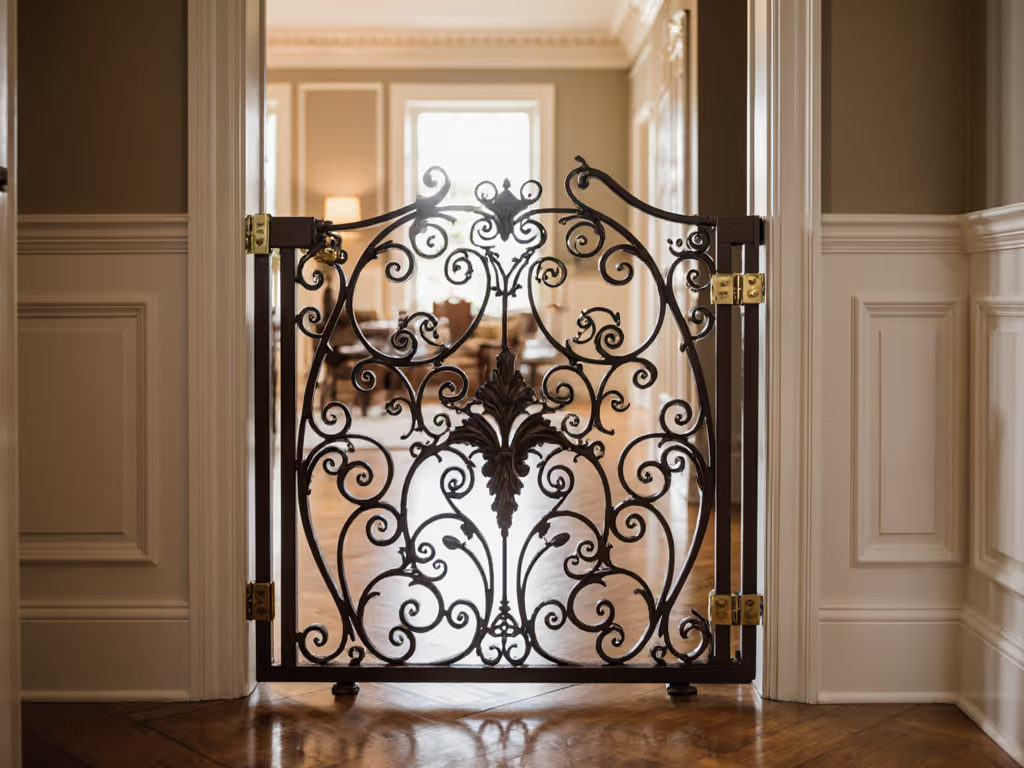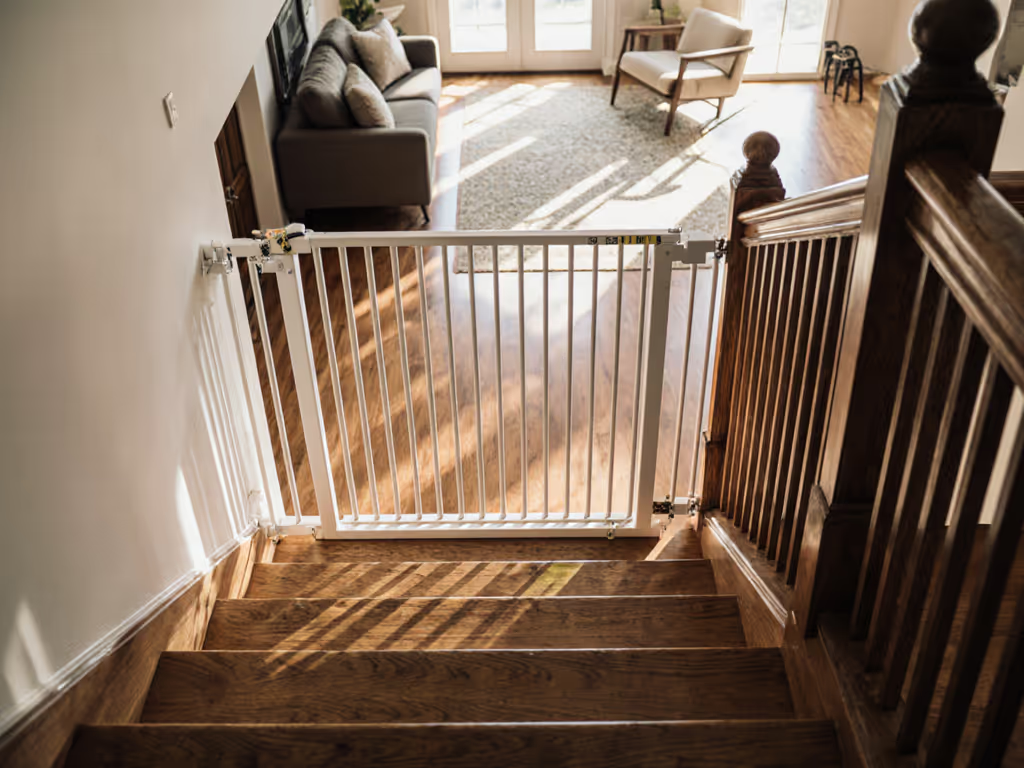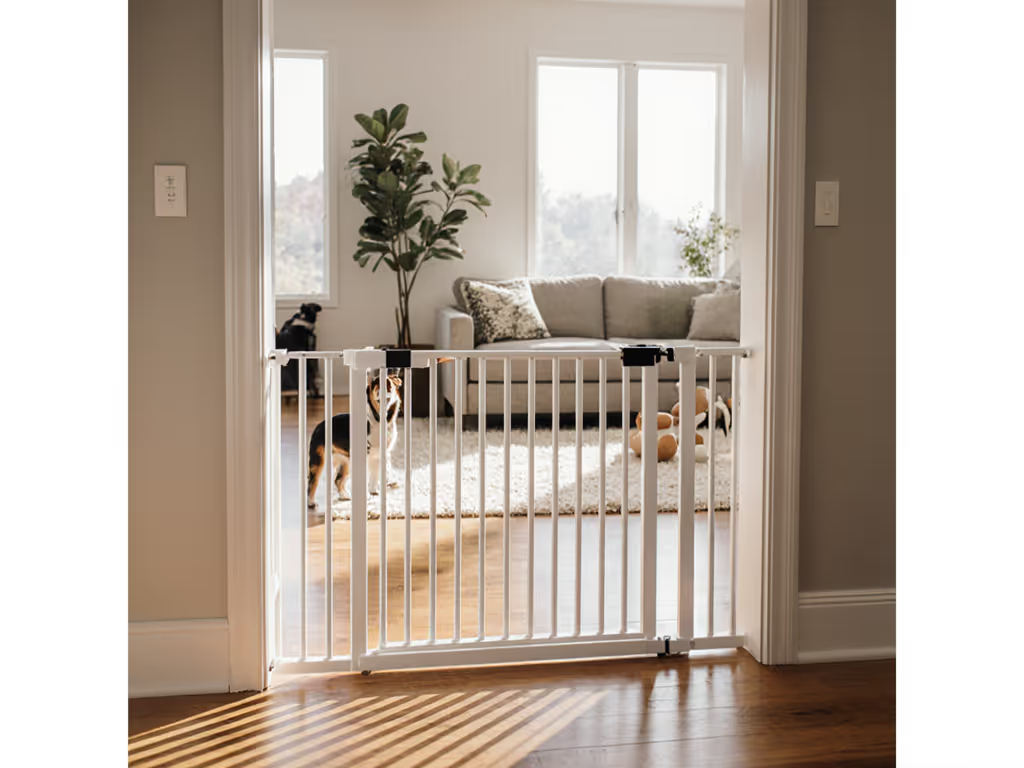
Top of Stairs Gates: Complete Safety Guide
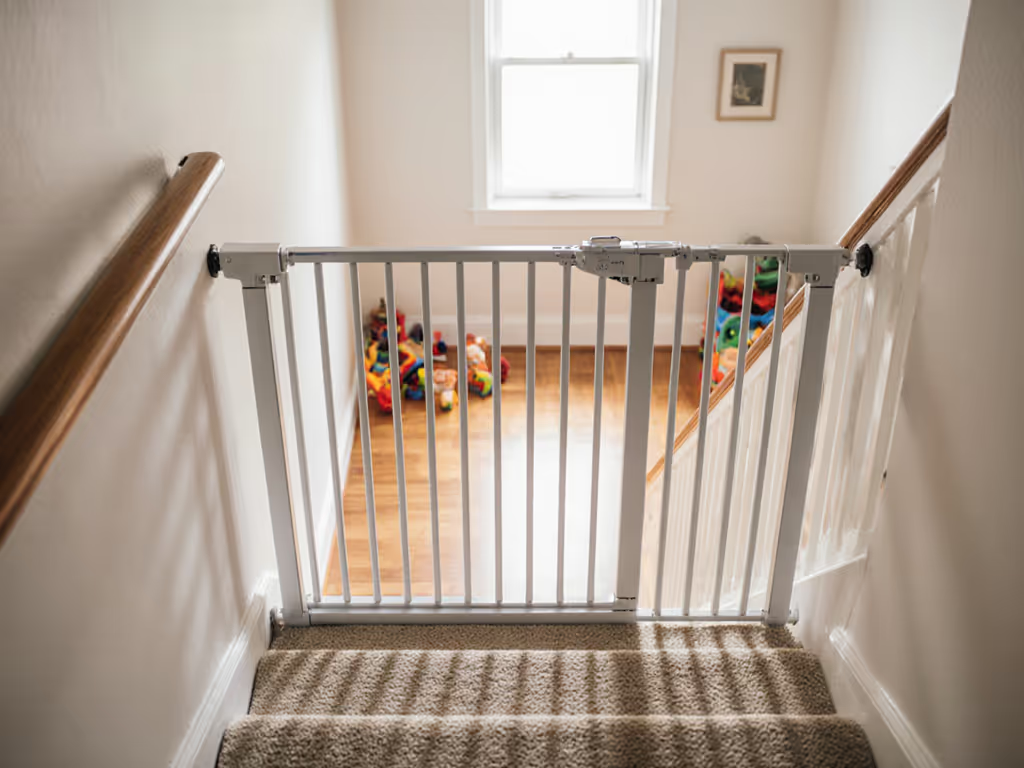
Every year, around 8,000 children end up in emergency rooms every day because of falls at home, many from staircases. Parents know that even a second’s distraction can have heartbreaking consequences, especially near stairs. Choosing the right gate for the top of the stairs is not just about convenience, it is a safety decision that can help prevent serious injuries and give families crucial peace of mind.
Key Takeaways
| Point | Details |
|---|---|
| Importance of Stair Gates | Stair gates are crucial for preventing serious injuries from staircase falls, which are a leading cause of non-fatal childhood injuries. |
| Gate Selection | Choose hardware-mounted gates for top of stairs due to their superior stability and safety over pressure-mounted options. |
| Installation and Maintenance | Proper installation into wall studs is essential; regular inspections and maintenance of gate hardware are critical to ensuring ongoing safety. |
| Active Supervision | No gate can replace vigilant adult supervision, which remains the ultimate safety measure for young children. |
Why Top of Stairs Gates Matter
Parents and caregivers face a critical safety challenge that demands immediate attention: protecting children from potentially fatal stair accidents. Staircase falls represent one of the most dangerous household risks for young children, with devastating consequences that can be easily prevented.
Research highlights the stark reality of child safety risks. Approximately five children under seven are treated in emergency departments daily due to baby gate-related incidents, underscoring the importance of proper gate installation and selection. Falls represent the leading cause of non-fatal childhood injuries in the United States, with around 8,000 children visiting emergency rooms every single day. These statistics aren't just numbers - they represent real children whose lives can be dramatically altered by a single moment of vulnerability.
When considering top of stairs gates, several key factors become critically important:
- Structural Integrity: Gates must withstand potential pressure and prevent accidental dislodging
- Secure Mounting: Proper installation is more important than the gate's design
- Height and Material: Tall gates made from durable materials provide maximum protection
- Ease of Use: Adult-friendly mechanisms ensure consistent usage
Effective stair gate protection isn't just about purchasing a product. It's about creating a comprehensive safety strategy that combines the right equipment with vigilant supervision. No gate can replace attentive caregiving, but the right gate can provide a crucial layer of protection during those inevitable moments when your attention might momentarily shift.
Types of Stair Gates and Key Differences
Navigating the world of child safety gates can feel overwhelming, but understanding the fundamental differences between gate types is crucial for protecting your little ones. Stair gates are not a one-size-fits-all solution, and choosing the wrong type can compromise your child's safety.
Two primary gate types dominate the market: hardware-mounted and pressure-mounted gates. Hardware-mounted gates are the gold standard for staircase protection, requiring permanent installation with screws directly into wall studs or door frames. These gates provide unparalleled stability and cannot be accidentally pushed or dislodged by curious children. Research consistently recommends hardware-mounted gates specifically for stairway locations due to their robust and secure attachment.
Key differences between gate types include:
Here's how hardware-mounted and pressure-mounted gates compare:
| Feature | Hardware-Mounted Gate | Pressure-Mounted Gate |
|---|---|---|
| Installation | Screwed into wall studs | Tension against walls |
| Stability | Highest<br>Cannot be dislodged | Moderate<br>Can be pushed out |
| Recommended Use | Top of stairs | Doorways<br>Between rooms |
| Safety Rating | Best for stairs | Not for stair tops |
| Ease of Removal | Requires tools | Easy, no tools needed |
| Installation Complexity | More complex | Quick and simple |
-
Hardware-Mounted Gates:
- Permanently screwed into wall structure
- Highest stability and safety rating
- Recommended for top of stairs
- Requires drilling and more complex installation
-
Pressure-Mounted Gates:
-
Held in place by tension against walls
-
Easy to install and remove
-
Best for doorways and between rooms
-
NOT recommended for stair tops due to potential displacement
-
Smart parents understand that gate selection is about more than just preventing falls. It's about creating a safe environment that allows children to explore while giving caregivers peace of mind. Always prioritize structural integrity and proper installation over convenience when protecting your most precious family members.
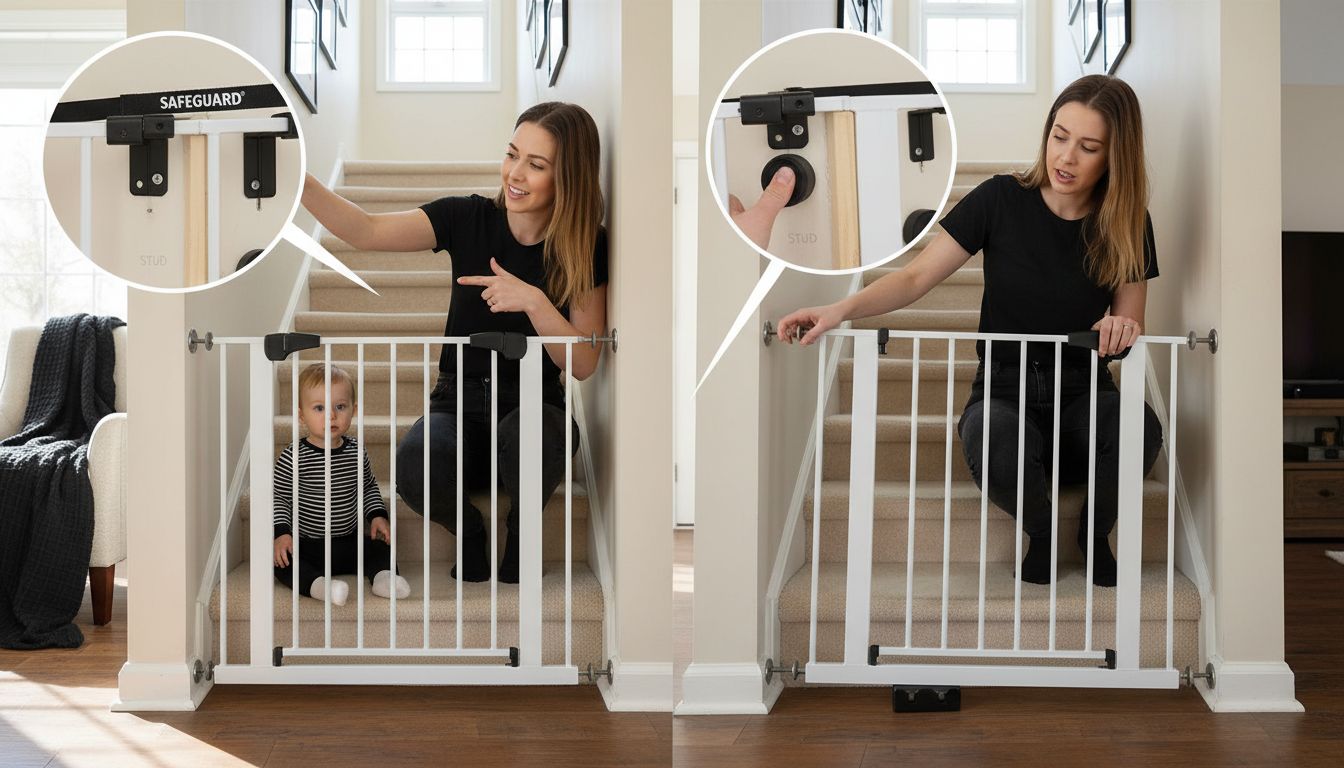
Essential Safety Features to Consider
Choosing a child safety gate isn't just about blocking a path - it's about creating a reliable barrier that protects your most vulnerable family members. Safety certification and careful design are critical components that separate effective gates from potentially dangerous ones.
The most crucial safety features begin with professional certifications. ASTM/JPMA certification serves as your first line of defense, ensuring the gate has passed rigorous safety standards. Experts recommend looking for gates with specific design elements that minimize potential injury risks. This includes limiting openings to no more than 2-3/8 inches to prevent head entrapment and selecting gates that are at least three-quarters the height of your child.
Key safety considerations include:
-
Structural Integrity:
- No sharp edges or protruding parts
- Robust construction that resists child pushing
- Smooth surfaces without potential pinch points
-
Installation Requirements:
- Hardware mounting at stair locations
- Secure, permanent attachment to walls
- No gaps between gate and mounting surface
-
Design Elements:
- One-handed opening mechanisms
- Automatic closing features
- Child-resistant locks
- Clear visual indicators when gate is properly closed
Beyond physical design, parent vigilance remains the ultimate safety feature. No gate can replace active supervision, but selecting a well-designed, professionally certified gate dramatically reduces childhood injury risks. Always inspect your gate regularly, ensure proper installation, and teach older children about safety boundaries.
Proper Installation and Usage Guidelines
Installing a stair gate isn't just about purchasing a product - it's about creating a precise safety barrier that protects your child from potential accidents. Professional research emphasizes the critical importance of meticulous installation techniques that go far beyond simply hanging a gate.
When mounting gates at stair locations, precision is paramount. Experts recommend installing hardware-mounted gates as soon as your child begins to sit up independently, positioning them less than 3 inches from the floor to prevent curious crawlers from squeezing underneath. The mounting surface must be solid and stable, typically requiring attachment directly into wall studs or solid structural supports. Never rely on drywall alone, as this can create a false sense of security that may lead to dangerous gate failure.
Key installation guidelines include:
-
Mounting Requirements:
- Use hardware-mounted gates for stairs
- Attach directly to wall studs
- Ensure less than 3 inches of clearance from floor
- Check mounting points for absolute stability
-
Usage Protocols:
- Always close gate completely after passing
- Teach older children proper gate operation
- Regularly inspect mounting hardware
- Replace gates showing signs of wear
-
Ongoing Maintenance:
-
Check mounting screws monthly
-
Test gate stability quarterly
-
Ensure no structural damage or loosening
-
Replace gate every 2-3 years or after significant stress
-
Remember, a gate is only as good as its installation and maintenance. No safety device can replace active parental supervision, but a properly installed gate provides a critical layer of protection during those split-second moments when your attention might momentarily shift.
Risks of Not Using Stair Gates Effectively
Every parent's worst nightmare is a preventable child injury, and stair-related accidents represent one of the most common and dangerous household risks. The statistics are sobering: approximately 8,000 children visit emergency rooms daily due to falls, with stairs being a primary source of these potentially traumatic incidents.
Improperly secured or neglected stair gates create multiple hazards that can transform an ordinary home into a danger zone. Research indicates that about five children under seven are treated daily in U.S. emergency departments specifically for baby gate-related injuries. This means that not only can unsecured stairs lead to falls, but improperly installed gates themselves can become additional injury vectors. Children are naturally curious and surprisingly strong - they can push down unsecured gates, creating false barriers that provide a dangerous illusion of safety.
The most significant risks of ineffective stair gate usage include:
-
Physical Injury Risks:
- Potential head trauma
- Broken bones
- Severe bruising
- Potential long-term developmental complications
-
Psychological Impact:
- Potential lasting fear of stairs
- Decreased confidence in movement
- Parental anxiety and guilt
-
Long-Term Consequences:
- Medical expenses
- Potential rehabilitation needs
- Emotional trauma for entire family
Parental awareness and proactive safety measures are the most effective prevention strategies. Understanding that these aren't just hypothetical risks, but real, daily occurrences, can motivate caregivers to implement robust safety protocols. Remember, no gate is a substitute for active supervision, but a properly installed gate can be the critical barrier between curiosity and catastrophe.
Protect Your Child with the Right Top of Stairs Gate
Falling down stairs is one of the most frightening risks you face as a parent or caregiver. This article highlights the critical importance of choosing a hardware-mounted gate that offers secure, reliable protection at the top of stairs. If you are worried about the safety of your little one and want to avoid accidents caused by weak or improperly installed gates, you are not alone. Many parents share the same concern for structural integrity, certified safety features, and expert installation advice to keep children safe.
Don't wait until an injury happens. Start building your home safety plan today by exploring trusted advice and carefully reviewed gate options. Visit BabySafetyGates.World for detailed guides on gate types, installation tips, and how to select the best fit for your staircase. Ready to take the next step in preventing stair accidents? See our extensive resources and product reviews at Baby Safety Gates and ensure your child’s safety is never compromised.
Frequently Asked Questions
What are the key safety features to look for in a top of stairs gate?
Look for safety certifications such as ASTM/JPMA, structural integrity without sharp edges, secure mounting requirements, and design elements like one-handed operation and child-resistant locks to prevent injuries.
How should I properly install a hardware-mounted stair gate?
Install the gate by screwing it directly into wall studs, ensuring a clearance of less than 3 inches from the floor. Check the stability of the mounting points and regularly inspect for any signs of wear or looseness.
What is the difference between hardware-mounted and pressure-mounted gates?
Hardware-mounted gates are screwed into wall studs, offering the highest stability and are recommended for stair use, while pressure-mounted gates rely on tension against walls, making them suitable for doorways but not safe for stair tops.
What are the risks of not using stair gates effectively?
Ineffective use of stair gates can lead to serious physical injuries like broken bones, potential head trauma, and even long-term psychological impacts. Poorly secured gates can become dangerous if children push them, leading to falls and accidents.

